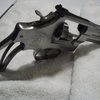Electric Head
Member
- Joined
- Jul 16, 2010
- Messages
- 81
- Reaction score
- 54
So this is probably an odd question to most people, but I notice little things and wonder about them.
It is also something that isn't really a big deal to me, it works and likely matters little, but technically it might.
So on modern smiths the cylinder turns anti-clockwise as viewed from the shooter's perspective.
I notice that everyone I see in a video closing the cylinder turn the cylinder clockwise as they close it (by pushing up with their thumb) to latch the cylinder on the bolt.
1 - This drags the bolt along the portion of the cylinder that usually never gets any contact with the bolt as in that part of the rotation, it is down from just being pulled down by the trigger. About halfway to the next cylinder notch is where the bolt is release and starts riding on the cylinder again.
EDIT: There's also the fact that when the bolt latches the cylinder this way, it falls from the full circumference height of the cylinder into the bottom of the notch. When rotating in the operating direction, it is only falling about half as far due to the guide ramp (or whatever you call it) going into each notch. I imagine you could spin it fast enough the wrong way to make the bolt skip the notch. You could not do that going in the operating direction.
2 - To me, it is more natural just to close my left hand (thumb) which closes the cylinder and draws your thumb down, rotating the cylinder in the operating direction. Of course you need to watch how you've clocked the cylinder as you close it for the bolt to ride on the usual spot, but those I've seen closing it the other way seem to try to do that as well; It seems that part is a given step regardless.
I feel like those I've seen rotating it clockwise do so either because that is the direction the cylinder swings into the opening, or maybe because they assume clockwise is the correct direction, because it is clockwise.
So who else closes the cylinder and turns it anti-clockwise?
Who doesn't bother with trying to latch it at all?
Am I wrong? Have I missed something and have been doing it wrong myself?
It is also something that isn't really a big deal to me, it works and likely matters little, but technically it might.
So on modern smiths the cylinder turns anti-clockwise as viewed from the shooter's perspective.
I notice that everyone I see in a video closing the cylinder turn the cylinder clockwise as they close it (by pushing up with their thumb) to latch the cylinder on the bolt.
1 - This drags the bolt along the portion of the cylinder that usually never gets any contact with the bolt as in that part of the rotation, it is down from just being pulled down by the trigger. About halfway to the next cylinder notch is where the bolt is release and starts riding on the cylinder again.
EDIT: There's also the fact that when the bolt latches the cylinder this way, it falls from the full circumference height of the cylinder into the bottom of the notch. When rotating in the operating direction, it is only falling about half as far due to the guide ramp (or whatever you call it) going into each notch. I imagine you could spin it fast enough the wrong way to make the bolt skip the notch. You could not do that going in the operating direction.
2 - To me, it is more natural just to close my left hand (thumb) which closes the cylinder and draws your thumb down, rotating the cylinder in the operating direction. Of course you need to watch how you've clocked the cylinder as you close it for the bolt to ride on the usual spot, but those I've seen closing it the other way seem to try to do that as well; It seems that part is a given step regardless.
I feel like those I've seen rotating it clockwise do so either because that is the direction the cylinder swings into the opening, or maybe because they assume clockwise is the correct direction, because it is clockwise.
So who else closes the cylinder and turns it anti-clockwise?
Who doesn't bother with trying to latch it at all?
Am I wrong? Have I missed something and have been doing it wrong myself?
Last edited:


